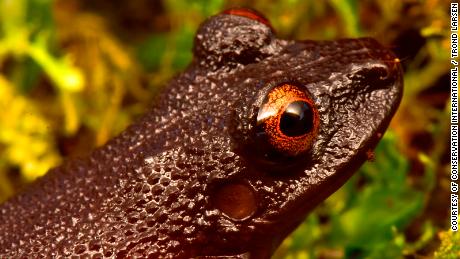(CNN)Sometimes, looking at things we thought we knew with fresh eyes (and new tools) can lead to incredible discoveries.
That's what happened when Jeff Weinell, a graduate research assistant at the University of Kansas' Biodiversity Institute, found out that three specimens of snakes preserved in the institute's biodiversity collection, found in field missions between 2006 and 2012 and overlooked up to this point, belonged in a category of their own.
The three snake specimens are the only known members of a new snake genus, called Levitonius, and a new snake species, called Levitonius mirus.
The findings by Weinell and colleagues, based on methods including DNA analysis and CT scans looking at the snakes' bone structure, were published Wednesday in the peer-reviewed journal Copeia.
The newly identified Levitonius mirus, also known as Waray dwarf burrowing snake, is native to the islands of Samar and Leyte in the Philippines, an exceptionally biodiverse archipelago that includes at least 112 land snake species, according to the study.
The snake has among the fewest number of vertebrae of any snake species in the world, according to the study, and has a long and narrow skull relative to its size, Weinell explained in a conversation with CNN. Its scales are highly iridescent, and it is likely that its diet is based on earthworms.
Weinell emphasized the importance of collaboration between US-based scientists and scientists in the Philippines, furthering the understanding of biodiversity in the region.
A serendipitous discovery
Originally, Weinell was interested in learning more about a group of snakes called Pseudorabdion.
"I sequenced DNA from a bunch of specimens of that group, and this one was actually misidentified as belonging to (Pseudorabdion)," Weinell told CNN.
"When I got the DNA results back, at first I thought it was just an error on my part, or contamination from the samples," Weinell said.
Further analysis of the snakes' scales and CT scans illuminating their bone structure revealed that Weinell had stumbled onto something new.
A 'miniaturized' snake
The snake is described as a "miniaturized" genus and species, much smaller than its closest relatives, Weinell said. While Levitonius mirus reaches at most 6.7 inches in length, "the size of a pencil," he said, "the closest relatives could be three to four times larger."
"That has a lot of consequences, like reduction of the number of bones, a sort of simplification of the body," Weinell said.
"Miniaturization hasn't been observed that often, at least in snakes," the KU graduate research assistant said, and this snake represents one of the most extreme cases within the larger clade it belongs in, called Elapoidea. That clade also includes larger and venomous snakes such as cobras and mambas. Weinell said Levitonius mirus is unlikely to be venomous.
An elusive burrower
The three specimens that were examined in the study are the only known ones ever found, and the snake has never been photographed alive, Weinell told CNN.
He tried to accomplish that in 2017, by traveling to the Philippines, but his expedition was unsuccessful.
"There's still good habitat there for them to be there, but they live underground, so it's hard to find them unless you have the perfect conditions that might make them come out above the ground," Weinell explained.
A new genus, too
The findings extend beyond a species, to a whole genus of snakes.
"We described the snake as not only a new species but as a new genus because it is very different morphologically from its closest relative, Oxyrhabdium, and because the amount of genetic divergence between Levitonius and Oxyrhabdium is as high as what is usually observed between different genera," Weinell explained.
Weinell anticipates that more species in the genus will eventually be found in the Philippines, although the fact that these snakes adapted to life underground might complicate the scientists' task.
Naming new things
An especially exciting aspect of this study for Weinell was the ability to name a new genus and a new species.
The snake's common name honors the Waray-waray people who inhabit the area where the specimens were found. The scientific name, Levitonius mirus, honors Alan Leviton, a researcher at the California Academy of Sciences who spent decades studying snakes in the Philippines, and continues to do so to this day.
"He doesn't know, so this will be a surprise," Weinell said, speaking ahead of the findings' publication.
The word mirus, Latin for "extraordinary," speaks to the nature of Weinell's discovery.
"I was looking for something else and we got this, which is even cooler than what I was looking for," he said.
The importance of biodiversity collections
The fact that scientists could identify a new genus and species of snake based on specimens in a collection speaks to the importance of maintaining biodiversity repositories in research institutions and universities, according to study co-author Rafe Brown, professor of ecology and evolutionary biology and curator-in-charge of the KU Biodiversity Institute and Natural History Museum.
"In this case, the trained 'expert field biologists' misidentified specimens -- and we did so repeatedly, over years -- failing to recognize the significance of our finds, which were preserved and assumed to be somewhat unremarkable, nondescript juveniles of common snakes," Brown is quoted saying in a release.
"A lot of times the people who are in the field, including myself even, we may not know what we're looking at at the time when we could have made the discovery -- no one can really be the expert in all of it," Weinell said.
Biodiversity collections allow scientists to return to the specimens and continue studying them in new ways.
There is a lot more to be discovered, or rediscovered, especially as technology advances and new data becomes available to the scientists.
"Now that we're getting data from whole genomes of snakes, which is really changing our way of understanding evolution as a whole, really, how we define species is still continuing to change. How that affects things in the future is not yet clear," Weinell said.










